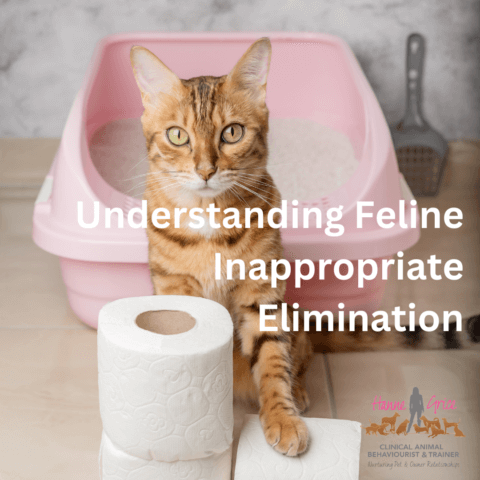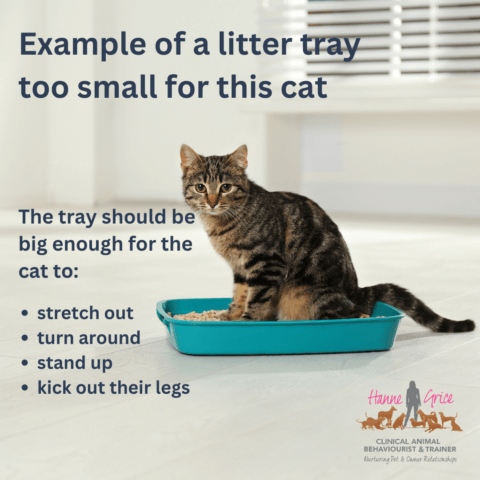Feline inappropriate elimination refers to a common behaviour problem in cats, where they eliminate inside the home and outside of their litter tray/box. This issue can be frustrating for cat owners and may indicate an underlying health or behavioural concern. Understanding the potential causes for inappropriate elimination is crucial in addressing this problem effectively. Additionally, implementing certain tips and strategies can help cat owners manage and prevent this behaviour. This article aims to provide an overview of feline inappropriate elimination, discuss some common causes, and offer tips for cat owners.

Understanding Feline Inappropriate Elimination
Feline inappropriate elimination is a term used to describe a situation where cats urinate or defecate outside their designated litter box areas. This behaviour is a common concern among cat owners and can be indicative of various underlying issues, such as medical problems, litter box aversion, or stress-related behaviour. Over recent years, I have worked with many cat owners that have needed help where their cats have been urinating up radiators, skirting boards, ovens and toasters, and defaecating on sofas, beds, countertops and more. Sometimes inappropriate elimination might be accompanied by other unwanted behaviours such as over-grooming, spats with other pets within the home, and eating of inappropriate items to name but a few.
There can be numerous causes for inappropriate elimination and engaging with your GP veterinarian is the first step to help with this issue. However, below is an overview of just some of the common causes for this behaviour.
Some of the Common Causes for Feline Inappropriate Elimination
- Medical Causes: numerous medical issues can prompt indoor elimination including but not limited to a.) Urinary Tract Infections (UTIs): Infections in the urinary system can cause cats to associate pain or discomfort with the litter box, leading to inappropriate elimination. b.) Feline Lower Urinary Tract Disease (FLUTD): FLUTD encompasses several conditions, including bladder stones, urinary blockages, and interstitial cystitis, which can result in inappropriate elimination. c.) Diabetes: Cats with diabetes may exhibit increased urination, leading to accidents outside the litter box. d.) Kidney Disease: Cats suffering from kidney disease may have increased water intake and subsequently increased urination, contributing to inappropriate elimination. e.) Arthritis: Cats with arthritis may find it challenging to access the litter box, leading to accidents – owners may also see a reluctance to use the cat flap and instead their cat may vocalise to be let in or out, if they are allowed access to roam. f) Constipation: When a cat experiences difficulty in passing stools due to constipation, they may associate the litter box with discomfort and pain. This negative association can lead to aversion towards the litter box, causing the cat to seek alternative places to relieve themselves.
- Behavioural Causes: some of the many contributory factors for indoor elimination include a.) Litter Box Aversion: Cats may develop an aversion to their litter box due to unpleasant associations, such as inappropriate substrate, inadequate cleanliness, location issues, where the box may be too small/enclosed/robotic, and or the box has tipped/wobbled when they were trying to use it/get in or out. b.) Stress and Anxiety: Environmental changes, introduction of new pets, reduced access to outdoor latrines due to building works or new neighbouring cats/dogs, visitors staying, a new baby, and or any household disruptions can cause stress and anxiety in cats, leading to inappropriate elimination as a coping mechanism. Cats are masters of feigning sleep/looking relaxed when in fact they may be distressed, as often the subtle signs of stress can be missed. It is not until there are overt signs of upset such as inappropriate elimination, fighting others, reduced activity or avoidance of approaching owners, will the cat owner realise something might be amiss.
Tips for Cat Owners

- Consult a Veterinarian: If your cat exhibits inappropriate elimination, it is essential to rule out any underlying medical conditions by consulting a veterinarian. This should include a thorough examination and conduct relevant tests to identify or rule out potential health issues, for example this might include but not limited to a urinalysis, faecal sample, complete blood count and so on.
- Maintain a Clean Litter Box: Ensure that the litter box is kept clean, as cats are naturally clean animals and may avoid a dirty litter box. Ensure the trays are cleaned out daily – scoop the poop and remove the clumped litter twice daily. Clean out the entire litter tray every 3 to 4 days. Thoroughly wash the litter tray when you do this, using unperfumed washing liquid and warm water (scrub clean and then dry).
- Provide Multiple Litter Boxes: If you have multiple cats, it is recommended to provide one litter box per cat, plus an additional one. This reduces competition and provides ample options for your cats.
- Optimise Litter Box Placement: Place the litter boxes in quiet and easily accessible areas of your home. Avoid high-traffic areas or locations that may cause stress to the cat, such as near loud appliances or household commotion (e.g. hallways, landings, kitchen etc).
- Test Out Different Trays and Litter. Cats need a tray that is large enough for them to fully stretch out, turn around, stand up and kick out their legs. Enclosed boxes and robotic cleaning boxes can worry some cats, so ensure you have open trays on offer – and consider purchasing under bed storage plastic trays/boxes (without wheels) as an option for larger cats. Additionally, try to experiment with various litter types to find the one your cat prefers. Some cats have preferences for certain textures such as grit rather than wood pellets, or scents, so offering different options of tray size/type and litter substrates, can encourage litter box use.
- Offer Environmental Enrichment: Provide your cat with mental and physical stimulation through interactive toys, scratching posts (horizonal, vertical and different textures), and increase vertical spaces via shelving/cat walks across the walks and even ceilings. This helps alleviate stress and boredom, avoids taking up precious ground space, and can help reduce the likelihood of inappropriate elimination.
- Manage Stressors: Minimise environmental changes and gradually introduce new elements, such as new pets or household routines. Go slow and take it at your pet’s own pace. Often when introducing another cat, clients may have done so over a week or less – this is too fast for most animals – so go slow, think weeks not days. If you have young children, other pets in the home or a busy household, do ensure you provide plenty of hiding spots and safe spaces that are high up for your cat to retreat to during stressful situations. If your cat is arthritic or has some joint/musculoskeletal pain, they may not be able to easily reach vertical space which involves jumping which then causes stress, so make sure they can access steps up to reduce jumping heights.
- Use Pheromone Products: Consider using synthetic feline pheromone diffusers or sprays, which can help create a calming environment and reduce anxiety-related elimination issues, for example Feliway Optimum.
- Consult a Behaviourist: If the inappropriate elimination persists despite medical intervention and environmental modifications, seek guidance from a Clinical Animal Behaviourist or Veterinary Behaviourist. They can provide tailored strategies and behaviour modification techniques. Check out the list of registered practitioners via the Animal Behaviour and Training Council.
In summary, feline inappropriate elimination can be a distressing issue for cat owners as well as cats, however, it can often be managed with proper understanding and intervention. By considering the potential medical and behavioural causes, consulting a veterinarian and behaviour therapist, and implementing appropriate strategies, cat owners can address this problem effectively.
Learn more about our classes

Get Hanne's Book
Playing With Your Dog will help any dog owner work out the games that are best suited for their pet to play throughout his life, from puppyhood to old age. The book also shares some tricks for all ages, group activities, and recommended toys that dogs will enjoy.

























